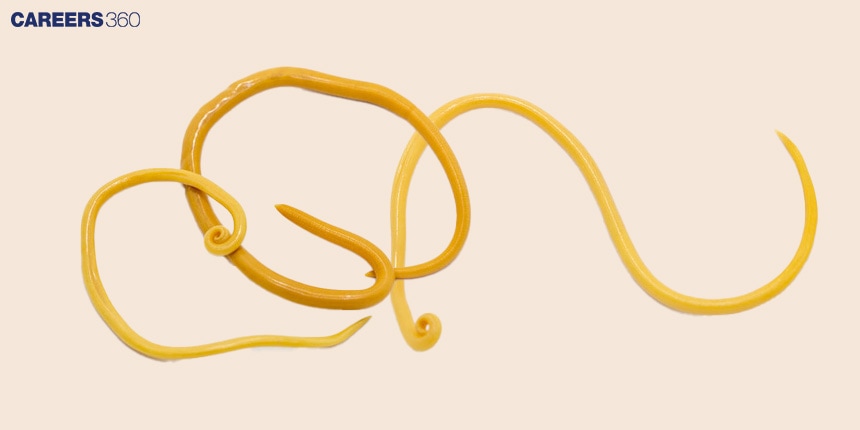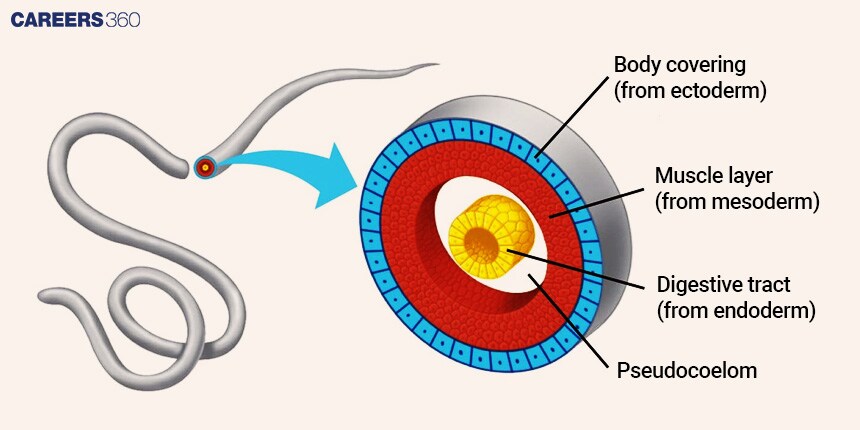Phylum Aschelminthes: Characteristics, Examples, Platyhelminthes, Classification, Topics
Aschelminthes, also known as roundworms, are a phylum of unsegmented, cylindrical worms with a pseudocoelom. They have a complete digestive system, and a protective cuticle and reproduce sexually. In this article, Aschelmithes, characteristics of phylum Aschelminthes, morphology and anatomy, major classes of Aschelminthes, ecological and economic importance, and diseases and parasitism are discussed. Phylum Aschelmithes is a topic of the chapter Animal Kingdom in Biology.
NEET 2025: Mock Test Series | Syllabus | High Scoring Topics | PYQs
NEET Important PYQ's Subject wise: Physics | Chemistry | Biology
New: Meet Careers360 B.Tech/NEET Experts in your City | Book your Seat now
- What is Phylum Aschelminthes?
- Characteristics of Phylum Aschelminthes
- Morphology and Anatomy
- Major Classes of Aschelminthes
- Ecological and Economic Importance
- Diseases and Parasitism

What is Phylum Aschelminthes?
Phylum Aschelminthes includes a group of worm-like invertebrates, otherwise called nematodes or roundworms, which are characteristically cylindrical with unsegmented bodies. Historically, the phylum Aschelminthes was considered a single phylum, but it became further divided into multiple phyla, with the nematodes being the best-studied ones. They were known and observed for centuries, but until recent decades, reasonably major forward steps were made in understanding their biology. Aschelminthes occupy quite an important place in the biological hierarchy due to the fact they are rather widely spread, perform some ecological functions, and have an impact on human health and agriculture.
Characteristics of Phylum Aschelminthes
The Aschelminthes are bilaterally symmetrical, which means they have an elongate, basically cylindrical body, mostly tapering at both ends and are covered with a tough, non-living cuticle.
They develop bilateral symmetry, wherein there is the presence of a definite head and tail region.
They possess a well-developed digestive system with a definite mouth and anus.
Reproduction in most of them is sexual. They are dioecious, though hermaphroditism is also found.
The habitats of Aschelminthes range from soil to freshwater, marine environments, and even as parasites in plants and animals.
Their life cycle ranges from simple direct development to highly complex cycles involving multiple hosts.
Aschelminthes Diagram
The diagram given below shows the internal structure of phylum Aschelminthes

Also Read-
Morphology and Anatomy
Morphology and anatomy in nematodes reflect an adaptation to most diverse habitats and life cycles, from free-living to parasitic forms.
External Morphology
The size of the nematodes can vary from microscopic to a few meters. Their body shape is cylindrical, normally tapered at both ends.
It has a flexible, non-living cuticle that periodically undergoes moulting. There are also surface structures that may comprise sensory bristles or papillae.
Internal Anatomy
A complete digestive system will have a tubular gut extending from mouth to anus.
A relatively simple nervous system, wherein a nerve ring is found in the region of the pharynx; also, longitudinal nerve cords extend posteriorly.
Excretion is carried out by modified excretory cells or canals, often called Flame cells.
They have complex systems of reproduction. In most instances, sexes are separate; female organs include ovaries, oviducts, and a uterus. Males have testes, copulatory spicules.
Major Classes of Aschelminthes
Aschelminthes, are phyla that are pseudocoelomate and invertebrate animals that are characterised by a simple body plan and a pseudocoelom. The differences among these classes are quite distinct.
Class Nematoda
Nematodes are unsegmented, cylindrical worms covered by a tough, flexible cuticle that they moult periodically.
They have a complete digestive system with a distinct mouth and anus.
They have a simple nervous system in that they do not have a brain but have a ring of nervous tissue around their pharynx with longitudinal nerve cords that run down their length.
Nematodes have a sexual mode of reproduction, which means most species have separate male and female genders. The fertilisation is internal.
They are highly diversified and are found in almost every habitat, which includes soil, freshwater, and marine environments, and as parasites in the plant and animal kingdom.
Examples
Ascaris lumbricoides: This is the most common nematode, or roundworm, that parasitises the intestines of humans.
Ancylostoma duodenale: Known as hookworm, it is responsible for anaemia and several other serious disorders.
Enterobius vermicularis: The pinworm; a nematode worm, inhabiting the intestines of children.
Class Rotifera
The rotifers are microscopic, aquatic animals that have their body divided into a head, trunk, and foot.
The head contains a rotating, ciliated organ, called the corona, used for locomotion and food capture.
They have a complete digestive system that contains a mastax, which is a unique pharynx provided with jaws to grind up the food.
Most rotifers are parthenogenetic, though some have sexual reproduction.
Mainly found in freshwater, some species inhibit marine and damp terrestrial habitats.
Examples
Brachionus plicatilis: A common rotifer species used in aquaculture.
Philodina roseola: A freshwater rotifer often used in scientific studies.
Class Gastrotricha
Gastrotrichs are tiny, worm-like flattened animals covered with cilia, which assist in locomotion and nourishment.
They have a simple digestive system with a mouth, pharynx, and intestine.
They have sexual and asexual ways of reproduction through parthenogenesis. Many of them are hermaphrodites.
Gastrotrichs are mainly inhabitants of freshwater and marine sediments, on algae.
Examples
Chaetonotus: A genus of freshwater gastrotrichs.
Lepidodermella: Another genus commonly found in freshwater habitats.
Class Kinorhyncha
Kinorhynchs are otherwise known as mud dragons.
Their body is segmented, having a head, neck, and trunk. The body is adequately plated and spined.
They can move around by extending and retracting their head.
They get their food from microorganisms and organic matter in the sediment.
It has sexual reproduction with two distinct sexes.
Mostly in sediments of marine environments.
Examples
Echinoderms: A genus of kinorhynchs commonly studied for their unique morphology and biology.
Ecological and Economic Importance
Nematodes are deeply involved in nutrient cycling and structural maintenance of soil through decomposing organic matter and by controlling microbial populations.
They contribute to the digestion of organic materials, thereby allowing for the re-circulation of nutrients through an ecosystem.
Most nematodes, however,-currently represent very important agricultural pests that damage crops due to root infestation and lead to economic losses.
Parasitic nematodes present several different diseases that cause pathogens in both humans and animals, resulting in health challenges and economic costs.
Nematodes, particularly Caenorhabditis elegans, have been used as model organisms in laboratory research due to the simplicity of these organisms and their well-mapped genetic structure.
Diseases and Parasitism
Common Diseases Caused by Aschelminthes are
Ascariasis: This is an infection by the helminth Ascaris lumbricoides, which mainly causes abdominal discomfort and malnutrition.
Hookworm infections: Infection by species such as Ancylostoma and Necator causes conditions such as anaemia and protein deficiency.
Filariasis is caused by filarial worms and might lead to conditions such as elephantiasis.
Enterobius vermicularis is the pinworm that causes enterobiasis. It makes it difficult to sleep and itches the anal region.
Also Read-
| Phylum Cnidaria | Notochord |
| Coelom | Phylum Porifera |
| Differences between Coelomate and Acoelomate | Digestive system of Earthworms |
Recommended Video on Phylum Aschelminthes:
Frequently Asked Questions (FAQs)
Aschelminthes are pseudo-celomate, unsegmented invertebrates with a simple body plan, bilateral symmetry, and a complete digestive system.
Entire arrays of health disorders, from malnutrition to intestinal blockage, are caused by roundworms of the genus Ascaris and the hookworm, anaemia, and bronchitis.
The economic importance of nematodes lies in both ways: on one side, their examples are regarded as useful soil dwellers; on the other, they comprise some elite parasites for crops, animals, and humans.
Prevention involves hygiene, safe food and water practices, and vector control; treatment includes antiparasitic medications and supportive care.
The major groups are two: Nematoda, the roundworms, and Rotifera, or rotifers. Other minor classes include Gastrotricha and Kinorhyncha.
Also Read
29 Nov'24 12:52 PM
26 Nov'24 04:23 PM
26 Nov'24 04:19 PM